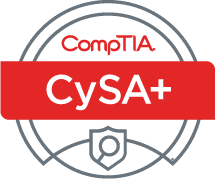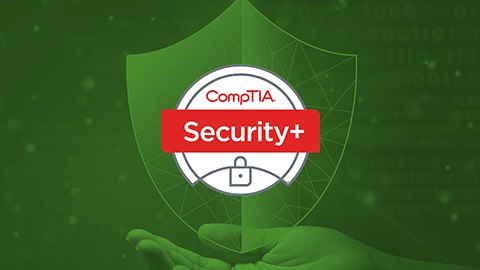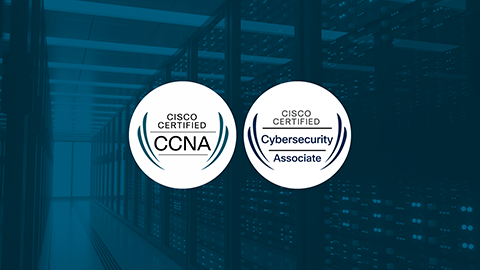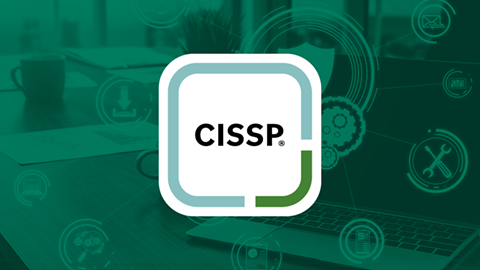
CompTIA Cybersecurity Analyst (CySA+) Certification Training Boot Camp
Infosec’s CySA+ training is designed to provide you with a comprehensive learning experience. Our boot camp combines in-depth content and practical exercises. Explore different dimensions of cybersecurity analysis and gain the knowledge and skills to configure and use the latest industry-standard threat detection tools. With a focus on data analysis, vulnerability identification and cyber threat exposure, you can help organizations secure their applications and systems.

What you'll learn
Training overview
The CompTIA CySA+ Training Boot Camp prepares you to pass the CompTIA Cybersecurity Analyst (CySA+) certification exam by covering the following domains:
- Threat and vulnerability management
- Software and systems security
- Security operations and monitoring
- Incident response
- Compliance and assessment
By the end of the CySA+ boot camp, you are prepared for the CySA+ certification exam and equipped with the behavioral analytics skills needed to increase cyber threat visibility.
What's included
Everything you need to know

- 90-day extended access to Boot Camp components, including class recordings
- 100% Satisfaction Guarantee
- Exam Pass Guarantee
- Exam voucher
- Free 90-day Infosec Skills subscription (access to 1,400+ additional courses and labs)
- Hands-on cyber ranges and labs
- Knowledge Transfer Guarantee
- Pre-study learning path
- Unlimited practice exam attempts
Syllabus
CySA+ certification course schedule
Day 1
Threat and vulnerability management
- Explain the importance of threat data and intelligence
- Given a scenario, utilize threat intelligence to support organizational security
- Given a scenario, perform vulnerability management activities
- Given a scenario, analyze the output from common vulnerability assessment tools
- Explain the threats and vulnerabilities associated with specialized technology
- Explain the threats and vulnerabilities associated with operating in the cloud
- Given a scenario, implement controls to mitigate attacks and software vulnerabilities
Threat and vulnerability management continued
Optional group & individual study
Schedule may vary from class to class
Day 2
Software and systems security
- Given a scenario, apply security solutions for infrastructure management
- Explain software assurance best practices
- Explain hardware assurance best practices
Software and systems security continued
Optional group & individual study
Schedule may vary from class to class
Day 3
Security operations and monitoring
- Given a scenario, analyze data as part of security monitoring activities
- Given a scenario, implement configuration changes to existing controls to improve security
- Explain the importance of proactive threat hunting
- Compare and contrast automation concepts and technologies
Security operations and monitoring continued
Optional group & individual study
Schedule may vary from class to class
Day 4
Incident response
- Explain the importance of the incident response process
- Given a scenario, apply the appropriate incident response procedure
- Given an incident, analyze potential indicators of compromise
- Given a scenario, utilize basic digital forensics techniques
Incident response continued
Optional group & individual study
Schedule may vary from class to class
Day 5
Compliance and assessment
- Understand the importance of data privacy and protection
- Given a scenario, apply security concepts in support of organizational risk mitigation
- Explain the importance of frameworks, policies, procedures and controls
Exam review
Take CS0-002 exam
Guaranteed results
Our Boot Camp guarantees
Exam Pass Guarantee
If you don’t pass your exam on the first attempt, get a second attempt for free. Includes the ability to re-sit the course for free for up to one year (does not apply to CMMC-AB Boot Camps).
100% Satisfaction Guarantee
If you’re not 100% satisfied with your training at the end of the first day, you may withdraw and enroll in a different online or in-person course.
Knowledge Transfer Guarantee
If an employee leaves within three months of obtaining certification, Infosec will train a different employee at the same organization tuition-free for up to one year.
Who should attend

The CompTIA CySA+ Training Boot Camp is designed for IT professionals looking to enhance their skills in identifying, assessing and evaluating organizational risk. This comprehensive training program is particularly beneficial for:
- Cybersecurity analysts
- Vulnerability analysts
- Cybersecurity specialists
- Anyone interested in building their skills as a cybersecurity analyst
After CYSA+ training, you have a deeper understanding of the tools, techniques and processes used in cybersecurity analysis. You can better investigate and combat cybercrime, extract valuable insights from data and contribute to the overall security strength of your company.
Learn more about the pre-requirements for earning the CySA+.
What makes the Infosec CySA+ prep course different?
As one of CompTIA’s top partners, you can rest assured that the CySA+ training materials are fully updated and synced with the latest version of the CySA+ exam. In addition, you’ll gain access to a CySA+ course the moment you enroll, so you can prepare for and get the most out of your boot camp.
With 20 years of training experience, we stand by our CySA+ training with an Exam Pass Guarantee. This means if you don’t pass the exam on the first attempt, we’ll pay for your second exam at no additional cost to you!
Meets 8570.1 requirements
Attention DoD Information Assurance workers! This boot camp helps meet U.S. Department of Defense Directive 8570.1 requirements for department employees or contractors engaged in work related to information security.
Before your boot camp
Prerequisites
What's next?
After you finish the CompTIA CySA+ Certification Boot Camp

Congratulations on completing the CompTIA CySA+ Training Boot Camp! You're now well-equipped with the knowledge and skills to excel in cybersecurity analysis.
The CySA+ certification meets the 8570.1 mandate and is approved for five job categories, including:
- Information Assurance Technician Level II
- Cybersecurity Service Provider (CSSP) – Analyst
- CSSP – Incident Responder
- CSSP – Infrastructure Support
- CSSP – Auditor
Infosec’s CySA+ online training is recognized and valued across government and private industries, making you a valuable asset to any organization's cybersecurity team.
Exam Prep
What are some tips I should know when preparing for the CySA+ exam?
To prepare for the CySA+ exam, study the four domains you will be tested on:
-
Security Operations
-
Vulnerability Management
-
Incident Response and Management
-
Reporting and Communication
You should review the exam structure, question style, and free training resources along with the exam content. Practice exams and online hubs about the CSA can prepare you for what to expect and help you earn your CySA+ certificate.
Career Opportunities
What are the career opportunities like for CySA+ certified professionals?
Obtaining the CompTIA CySA+ certification opens a wide range of career opportunities in the field of cybersecurity analysis. Common job titles and roles held by individuals with CySA+ certification include:
- Threat intelligence analyst
- Incident response analyst
- Compliance analyst
- Security consultant
- Security engineer
With your CySA+ certification, you'll have a competitive edge in the job market and be well-positioned for career growth and advancement. For details on CySA+ career opportunities, visit our CySA+ information page.
What job titles are most common for people with CompTIA’s CySA+ certification?
Some common positions that this certification can help you land include:
-

Security auditor
-

Security Operations Center (SOC) analyst
-

Vulnerability analysts
-

Security engineer
FAQ
Frequently asked questions
What is the advantage of doing CompTIA CySA+?
CompTIA certifications like the Cybersecurity Analyst (CySA+) are well-known in the industry and among the most requested by hiring managers. Earning your CySA+ certification demonstrates your intermediate-level cybersecurity knowledge and skills in the four domains on the CySA+ exam (CS0-003).
The CySA+ certification can lead to expanded career opportunities, validation of in-demand skills and a pathway for further growth in the cybersecurity field.
How long is the CySA+ certification exam?
The CompTIA CySA+ exam includes up to 85 multiple-choice and performance-based questions, which you have 165 minutes to complete. It is scored on a scale of 100–900, and a passing score is 750.
How long is the CySA+ certification valid?
Your CompTIA CySA+ certification lasts three years from the date you pass the exam. You can renew your CySA+ by earning continuing education units (CEUs), earning a higher level CompTIA certification like the CASP+ or a few other methods (see them all on the CompTIA website). Renewing your CySA+ extends the certification for an additional three years. For more details, read our CySA+ renewal process article.
Average Salary
CompTIA’s CySA+ certification salary expectations
A career in CompTIA CySA+ can be financially rewarding. While salaries vary depending on factors such as experience, location and industry, professionals with expertise in cybersecurity analysis can earn competitive salaries. Skilled CySA+ professionals earn an average of $110,929 per year. For more detailed information on salary trends and earning potential, please visit our CySA+ salary page.
View all schedule options
CompTIA Cybersecurity Analyst (CySA+) Certification Training Boot Camp
$2,849.00
CompTIA Cybersecurity Analyst (CySA+) Certification Training Boot Camp
$2,849.00
CompTIA Cybersecurity Analyst (CySA+) Certification Training Boot Camp
$2,849.00
CompTIA Cybersecurity Analyst (CySA+) Certification Training Boot Camp
$2,849.00
CompTIA Cybersecurity Analyst (CySA+) Certification Training Boot Camp
$2,849.00
CompTIA Cybersecurity Analyst (CySA+) Certification Training Boot Camp
$2,849.00
CompTIA Cybersecurity Analyst (CySA+) Certification Training Boot Camp
$2,849.00
CompTIA Cybersecurity Analyst (CySA+) Certification Training Boot Camp
$2,849.00
Quick facts
- Duration
- 5 days
- Method
- Live online or team onsite
- Level
- 1-3 years of experience
- Average salary
- $110,929
- Meets 8570.1 DoD requirements
Award-winning CySA+ course you can trust




Ready to discuss your training goals? We've got you covered.

Unlock team training discounts
If you’re like many of our clients, employee certification is more than a goal — it’s a business requirement. Connect with our team to learn more about our training discounts.
Request Team PricingQuick facts
- Duration
- 5 days
- Method
- Live online or team onsite
- Level
- 1-3 years of experience
- Average salary
- $110,929
- Meets 8570.1 DoD requirements
Award-winning CySA+ course you can trust




Explore our top boot camps





